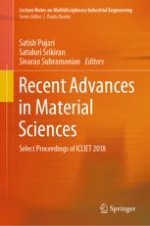This book comprises select proceedings of the International Conference on Latest Innovations in Materials Engineering and Technology (ICLIET 2018). The book focuses on diverse engineering materials, their design and applications. The materials in discussion include those related to coatings, polymers, composites, tribology, acoustic insulators, lubricants, and cryogenics. The book also highlights emerging nano and micro materials, bio engineering materials, as well as new energy materials for solar cells and photovoltaic cells. This book will serve as an useful reference for students, researchers, and professionals working in the field of materials science and engineering.
